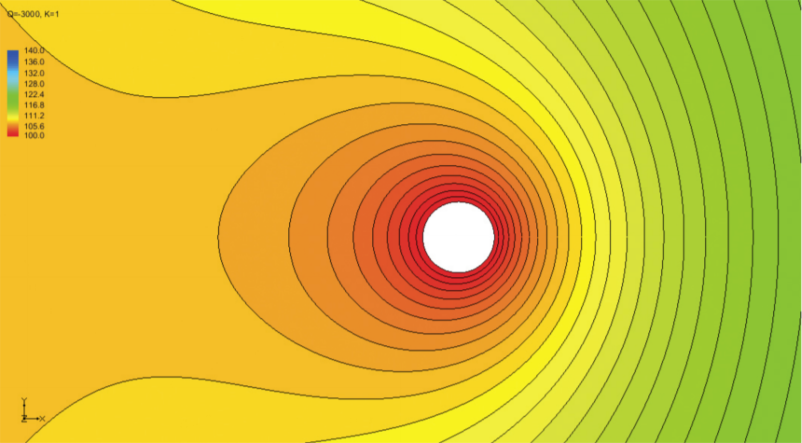Development of a simple method for determining the influence radius of a pumping well in steady-state condition
doi: 10.19637/j.cnki.2305-7068.2020.02.001
Development of a simple method for determining the influence radius of a pumping well in steady-state condition
-
Abstract:
Influence radius of a pumping well is a crucial parameter for hydrogeologists and engineers. Knowing the radius of influence for a designed drawdown enables one to calculate the pumping rate required to layout a project foundation that may need lowering of groundwater level to a certain depth due to dewatering operation. In addition, this is important for hydrogeologists to determine ground water contamination flow paths and contributing recharge area for domestic water supply and aquifer management purposes. Empirical formulas that usually neglect vital parameters to determine the influence radius accurately have been traditionally utilized due to lack of adequate methods. In this study, a physically based method, which incorporates aquifer hydraulic gradient for determining the influence radius of a pumping well in steady-state flow condition, was developed. It utilizes Darcy and Dupuit laws to calculate the influence radius, where Darcy’s law and Dupuit equation, in steady-state condition, represent the inflow and the outflow of the pumping well, respectively. In an untraditional manner, this method can be also used to determine aquifer hydraulic conductivity as an alternative to other pumping test methods with high degree of accuracy. The developed method is easy to use; where a simple mathematical calculator may be used to calculate the influence radius and the pumping rate or hydraulic conductivity. By comparing the results from this method with the MODFLOW numerical model outputs with different simulated scenarios, it is realized that this method is much superior and more advantageous than other commonly used empirical methods.
-
Key words:
- Radius of influence /
- Dewatering /
- Hydraulic gradient /
- Hydraulic conductivity /
- Pumping rate /
- Aquifer management
-
Gefell MJ, Thomas GM, Rossello SJ. 1994. Maximum water-table drawdown at a fully penetrating pumping well. Ground Water, 32 Soni AK, Sahoo LK, Ghosh UK. 2015. Importance of radius of influence and its estimation in a limestone quarry, Journal of the Institution of Engineers (India): Series D, 96(1): 77-83. Sen Z. 1995. Applied hydrogeology for scientists and engineers. Lewis Publishers Inc, CRC Press. Fileccia A. 2015. Some simple procedures for the calculation of the influence radius and well head protection areas (theoretical approach and a field case for a water table aquifer in an alluvial plain). Italian Journal of Groundwater-AS14065: 007-023. Lembke KE. 1887. Groundwater flow and the theory of water collectors. The Engineer, Journal of the Ministry of Communications,2: 17-19. Bear J. 1979. Hydraulics of groundwater. New York: McGraw Hill. Dragoni W. 1998. Some considerations regarding the radius or influence or a pumping well. Hydrogéologie, 3: 21-25. Theis CV. 1935. The relation between the lowering of the piezometric surface and the rate and duration of discharge of a well using ground-water storage. Transaction, American Geophysical Union, 16(2): 519-524. : 411-419. Todd DK. 1980. Groundwater hydrology, second edition. New York: John Wiley and Sons Inc, Chichester Brisbane Toronto: 535. a case study of South Africa, Water South Africa, 41 (1): 71-78. Yihdego Y. 2018. Engineering and enviromanagement value of radius of influence estimate from mining excavation, Journal of Applied Water Engineering and Research,6(4): 329-337. : 217-229. Polomcic D, Bajic D, Zaric J. 2015. Determing the groundwater balance and radius of influence using hydrodynamic modeling: Case study of the groundwater source Sumice in Serbia. Journal of Sustainable Development of Energy, Water and Environment Systems, 3 Seward P, Xu Y, Turton A. 2015. Investigating a spatial approach to groundwater quantity management using radius of influence with Lakshmi NR. 2003. Seepage in soils: Principles and applications. John Wiley and Sons Inc. Aquaveo. 2015. Groundwater modeling system (GMS), version 10.0. Bremer J, Harter T. 2008. Domestic well capture zone and influence of gravel pack length. Ground Water, 47(2): 277-286. -

 E-mail alert
E-mail alert Rss
Rss



 下载:
下载:








